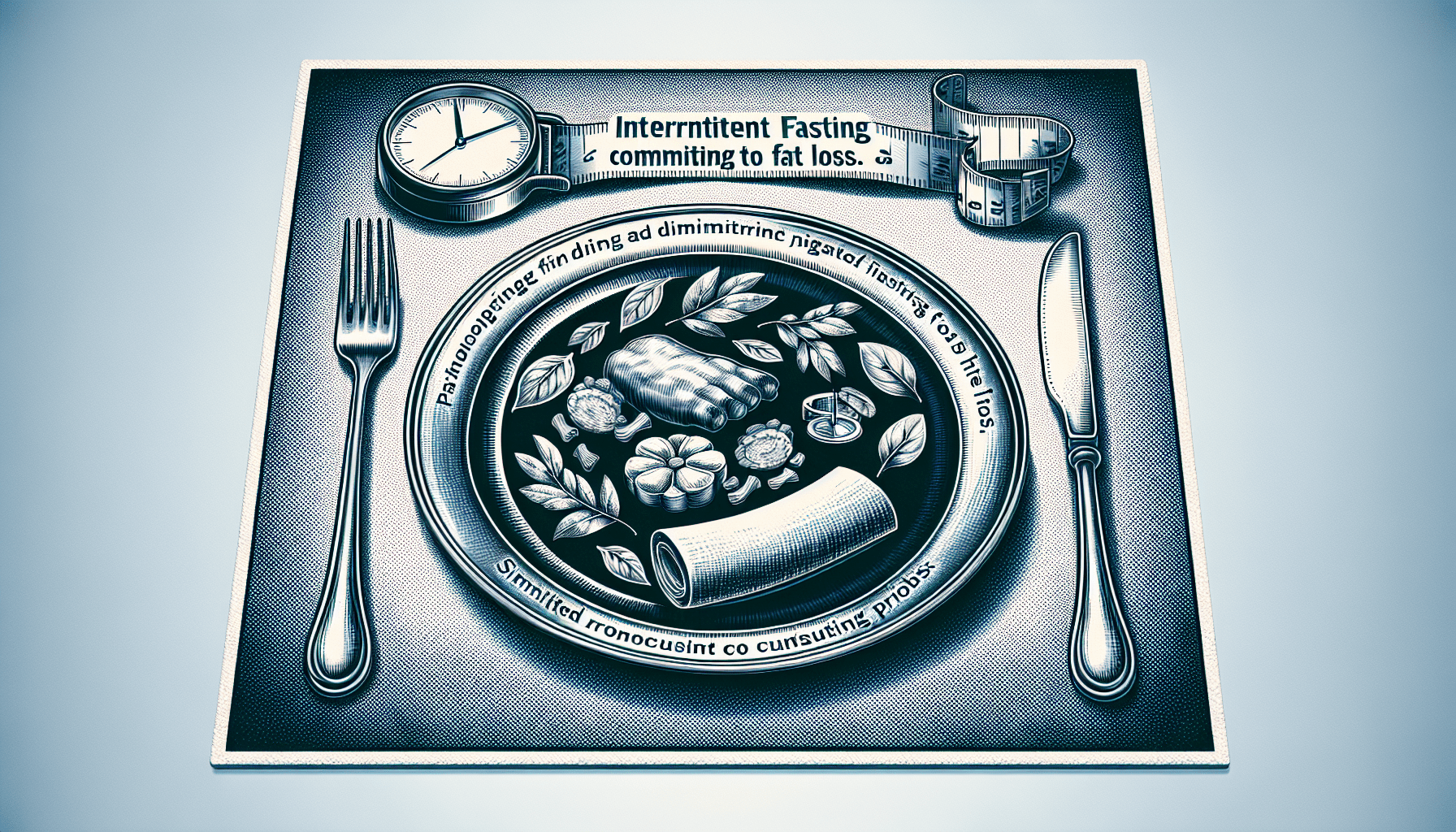Looking to shed some extra pounds? Have you heard about intermittent fasting? This popular trend in the fitness world has been gaining attention for its potential benefits in weight loss. But does it really work? In this article, we explore the effectiveness of intermittent fasting in fat loss and provide you with insights that may help you make an informed decision on whether to give it a try. So, grab a healthy snack and let’s dive into the world of intermittent fasting!
What is intermittent fasting?
Intermittent fasting is a dietary approach that involves limiting your eating periods and alternating between periods of fasting and feasting. It is not a diet in the traditional sense where you have strict guidelines on what to eat, but rather focuses on when you eat.
Explanation of intermittent fasting
Intermittent fasting works on the principle of calorie restriction. By reducing the number of hours in which you consume food, you naturally reduce your calorie intake. This can lead to weight loss, as your body begins to utilize stored fat for energy instead of relying on the calories from your meals.
Types of intermittent fasting
There are several different methods of intermittent fasting, all of which involve alternating between periods of eating and fasting. The most common ones include the 16/8 method, where you fast for 16 hours and eat within an 8-hour window, and the 5:2 method, where you eat normally for 5 days and restrict your calorie intake to 500-600 calories for 2 non-consecutive days.
How it works
Intermittent fasting works by tapping into your body’s natural ability to burn fat for fuel during periods of fasting. When you fast, your insulin levels drop and your body begins to break down stored fat for energy. By extending the fasting period, your body has more time to burn fat, leading to weight loss over time.
Benefits of intermittent fasting for fat loss
Reduced calorie intake
One of the key benefits of intermittent fasting for fat loss is its ability to naturally reduce calorie intake. By shortening the window in which you eat, it becomes more challenging to consume excess calories. This can create a calorie deficit, which is necessary for weight loss.
Increased fat burning
Intermittent fasting promotes the process of fat oxidation, where your body uses stored fat as fuel. When your body is in a fasted state, it switches from using carbohydrates as its primary energy source to relying on stored fat. This can lead to increased fat burning and ultimately result in fat loss.
Improved insulin sensitivity
Intermittent fasting has been shown to improve insulin sensitivity. This means that your body becomes more efficient at utilizing insulin and glucose, resulting in better blood sugar control. This can be beneficial for fat loss, as improved insulin sensitivity can help prevent excess fat storage.
Preservation of muscle mass
One concern with any weight loss program is the potential loss of muscle mass along with fat. However, research has shown that intermittent fasting can help preserve muscle mass while promoting fat loss. By combining intermittent fasting with resistance training, you can further enhance muscle preservation during weight loss.
Enhanced metabolism
Intermittent fasting can also have a positive impact on your metabolism. Studies have shown that it can increase levels of human growth hormone (HGH), which plays a role in fat metabolism and muscle growth. Additionally, intermittent fasting may increase your metabolic rate, helping you burn more calories throughout the day.
Research on intermittent fasting and fat loss
Study 1: Effects of intermittent fasting on body composition
A study published in the Journal of Translational Medicine found that intermittent fasting can lead to significant reductions in body weight and body fat percentage. The study compared two groups of overweight individuals, with one group following an intermittent fasting protocol and the other group following a traditional calorie-restricted diet. The intermittent fasting group experienced greater fat loss and preserved more muscle mass compared to the calorie-restricted group.
Study 2: Comparison of intermittent fasting and continuous calorie restriction
A study published in the International Journal of Obesity compared the effects of intermittent fasting and continuous calorie restriction on weight loss. The study found that both methods were equally effective in reducing body weight and body fat. However, the intermittent fasting group had higher fat-free mass, indicating better preservation of muscle mass during weight loss.
Study 3: Impact of intermittent fasting on metabolic markers
A study published in the Journal of Nutrition and Metabolism examined the effects of intermittent fasting on various metabolic markers. The study found that intermittent fasting resulted in improvements in blood lipid levels, including decreases in total cholesterol and LDL cholesterol. It also led to reductions in blood pressure and markers of inflammation, which are associated with an increased risk of heart disease.
Study 4: Intermittent fasting and abdominal fat reduction
A study published in the journal Obesity assessed the effects of intermittent fasting on abdominal fat reduction. The study found that intermittent fasting led to a significant reduction in waist circumference, indicating a reduction in abdominal fat. This is important, as abdominal fat is associated with an increased risk of chronic diseases, such as type 2 diabetes and cardiovascular disease.

Potential drawbacks and considerations
Increased hunger during fasting periods
One potential drawback of intermittent fasting is increased hunger during the fasting periods. It can take time for your body to adjust to a new eating pattern, and you may experience hunger pangs, especially in the beginning. However, over time, many individuals find that their hunger levels stabilize, and intermittent fasting becomes more manageable.
Possible negative effects on certain individuals
While intermittent fasting can be beneficial for many individuals, it may not be suitable for everyone. People with certain medical conditions, such as diabetes or a history of eating disorders, should approach intermittent fasting with caution and consult with a healthcare professional before starting. It’s important to prioritize your health and well-being when considering any dietary changes.
Adherence challenges
Intermittent fasting may pose adherence challenges for some individuals. It requires discipline and consistency to stick to the prescribed fasting windows. It’s important to find a schedule that suits your lifestyle and commitments, as well as considering your individual preferences and hunger levels. Experimenting with different fasting methods can help you find what works best for you.
Lack of long-term studies
While intermittent fasting has gained popularity in recent years, there is still a lack of long-term studies assessing its effectiveness for fat loss. Most studies have been conducted over a relatively short period of time, making it difficult to draw conclusions about the long-term effects of intermittent fasting. More research is needed to understand the potential benefits and drawbacks of long-term adherence to intermittent fasting.
Tips for successful intermittent fasting
Start with shorter fasting windows
If you’re new to intermittent fasting, it can be helpful to start with shorter fasting windows and gradually increase the duration as you become more comfortable. This allows your body to adapt to the new eating pattern without feeling overwhelmed. Starting with a 12-hour fasting window, such as fasting from 8 pm to 8 am, can be a good place to begin.
Stay hydrated
During fasting periods, it’s important to stay hydrated. Drinking water, herbal tea, or black coffee can help curb hunger and keep you hydrated. Avoid sugary drinks or excessive amounts of caffeine, as they may interfere with the benefits of fasting. Remember, intermittent fasting is about restricting calorie intake, not fluid intake.
Include balanced meals during eating periods
When it’s time to eat, focus on consuming balanced meals that include a variety of nutrient-dense foods. Aim for a balance of protein, carbohydrates, and healthy fats, along with plenty of fruits and vegetables. This will provide your body with the necessary nutrients to support fat loss and overall health.
Listen to your body
It’s important to listen to your body and pay attention to its hunger and fullness cues. Intermittent fasting should not be used as an excuse to ignore hunger or overeat during eating periods. If you’re feeling excessively hungry or experiencing any negative symptoms, such as dizziness or fatigue, it’s essential to adjust your fasting schedule accordingly and prioritize your health and well-being.
Find a schedule that suits your lifestyle
To ensure long-term success with intermittent fasting, it’s crucial to find a fasting schedule that suits your lifestyle and preferences. There is no one-size-fits-all approach, so experiment with different fasting methods and find what works best for you. Whether it’s the 16/8 method, the 5:2 method, or another variation, find a schedule that you can easily adhere to and sustain in the long run.
Who should avoid intermittent fasting for fat loss?
Pregnant or breastfeeding women
Intermittent fasting is not recommended for pregnant or breastfeeding women. During these times, it’s important to ensure an adequate intake of nutrients to support the health and development of both the mother and the baby. Restricting calorie intake through intermittent fasting may not provide sufficient nutrients for optimal pregnancy or breastfeeding outcomes.
Individuals with a history of eating disorders
If you have a history of eating disorders, such as anorexia or bulimia, it’s crucial to approach intermittent fasting with caution. Restricting your eating periods may trigger old patterns of disordered eating and potentially exacerbate your condition. Consult with a healthcare professional before considering intermittent fasting if you have a history of eating disorders.
People with certain medical conditions
Intermittent fasting may not be suitable for individuals with certain medical conditions. If you have diabetes, hypoglycemia, or any other chronic condition that requires regular or controlled meals, it’s important to consult with a healthcare professional to ensure that intermittent fasting is safe for you. Individualized guidance is essential to ensure you can manage your condition while attempting intermittent fasting.
Consultation with a healthcare professional
Before starting any new diet or fasting regimen, it’s always a good idea to consult with a healthcare professional. They can provide individualized guidance based on your unique circumstances and help assess whether intermittent fasting is appropriate for you.
Other factors to consider for fat loss
Importance of overall diet quality
While intermittent fasting can be effective for fat loss, it’s important to remember that overall diet quality plays a significant role in achieving and maintaining a healthy weight. It’s essential to focus on consuming a variety of nutrient-rich foods, such as lean proteins, whole grains, fruits, vegetables, and healthy fats. Combining intermittent fasting with a balanced and nutritious diet can maximize your fat loss results.
Regular physical activity
Physical activity is another crucial component of a comprehensive fat loss plan. Combining intermittent fasting with regular exercise can help optimize your results. Engage in a combination of cardiovascular exercise and strength training to promote fat loss, preserve lean muscle mass, and improve overall fitness levels.
Adequate sleep and stress management
Getting enough sleep and managing stress levels are often overlooked factors in achieving fat loss goals. Poor sleep and chronic stress can disrupt hormones involved in appetite regulation and fat storage. Aim for 7-9 hours of quality sleep each night and incorporate stress management techniques, such as meditation or yoga, into your routine.
Individual differences in response to fasting
It’s important to recognize that individual responses to intermittent fasting can vary. Some people may experience rapid weight loss, while others may see more gradual progress. Remember that weight loss is not always linear, and everyone’s body is unique. Focus on adopting a sustainable approach that works for you and supports your long-term goals.
Intermittent fasting as part of a comprehensive fat loss plan
Combining intermittent fasting with other diet strategies
Intermittent fasting can be combined with other diet strategies to enhance fat loss results. For example, adopting a low-carbohydrate or ketogenic diet during eating periods can help optimize fat burning. However, it’s important to find a combination that works for you and aligns with your dietary preferences and goals.
Including exercise for optimal fat loss
While intermittent fasting can promote fat loss, it’s important to incorporate exercise into your routine for optimal results. Engaging in regular physical activity can help increase calorie expenditure, build lean muscle mass, and improve overall fitness. Aim for a combination of cardiovascular exercise and strength training to optimize fat loss and support your overall health and well-being.
Creating a sustainable approach
Sustainability is key when it comes to fat loss. Instead of viewing intermittent fasting as a short-term solution, approach it as a long-term lifestyle change. Find a fasting schedule that you enjoy and can maintain in the long run. Focus on consuming a balanced and nutrient-dense diet, engaging in regular physical activity, and prioritizing self-care to create a sustainable approach to fat loss.
Common myths and misconceptions about intermittent fasting for fat loss
Starvation mode
One common myth is that intermittent fasting puts your body into starvation mode, causing it to hold onto fat. However, this is not the case. The body is capable of adapting to different eating patterns, and intermittent fasting does not significantly reduce your metabolic rate. As long as you provide your body with adequate nutrients during eating periods, it will not go into starvation mode.
Losing muscle mass
Another misconception is that intermittent fasting leads to muscle loss. While it’s possible to lose muscle mass during any weight loss program, combining intermittent fasting with resistance training can help preserve muscle mass. This is especially important for overall body composition and maintaining a healthy metabolism.
Slowing down metabolism
Intermittent fasting does not slow down your metabolism. In fact, studies have shown that it may have a positive effect on metabolic rate. When done correctly, intermittent fasting can enhance fat metabolism and improve insulin sensitivity, both of which can support a healthy metabolism.
Necessity of extreme fasting durations
Intermittent fasting does not require extreme fasting durations to be effective for fat loss. While some individuals may choose to follow longer fasting windows, such as 24 or 36 hours, it’s not necessary for achieving results. The key is to find a fasting schedule that fits your lifestyle and can be sustained in the long run.
Conclusion
In conclusion, intermittent fasting can be an effective strategy for fat loss. By reducing calorie intake, increasing fat burning, improving insulin sensitivity, preserving muscle mass, and enhancing metabolism, intermittent fasting has the potential to support weight loss goals. However, it’s important to consider potential drawbacks, individual differences, and the need for comprehensive lifestyle factors, such as overall diet quality, regular physical activity, and adequate sleep. Consultation with a healthcare professional is recommended, especially if you have any underlying medical conditions or history of eating disorders. Ultimately, finding a sustainable approach that aligns with your goals and preferences is key to achieving long-term success with intermittent fasting for fat loss.




